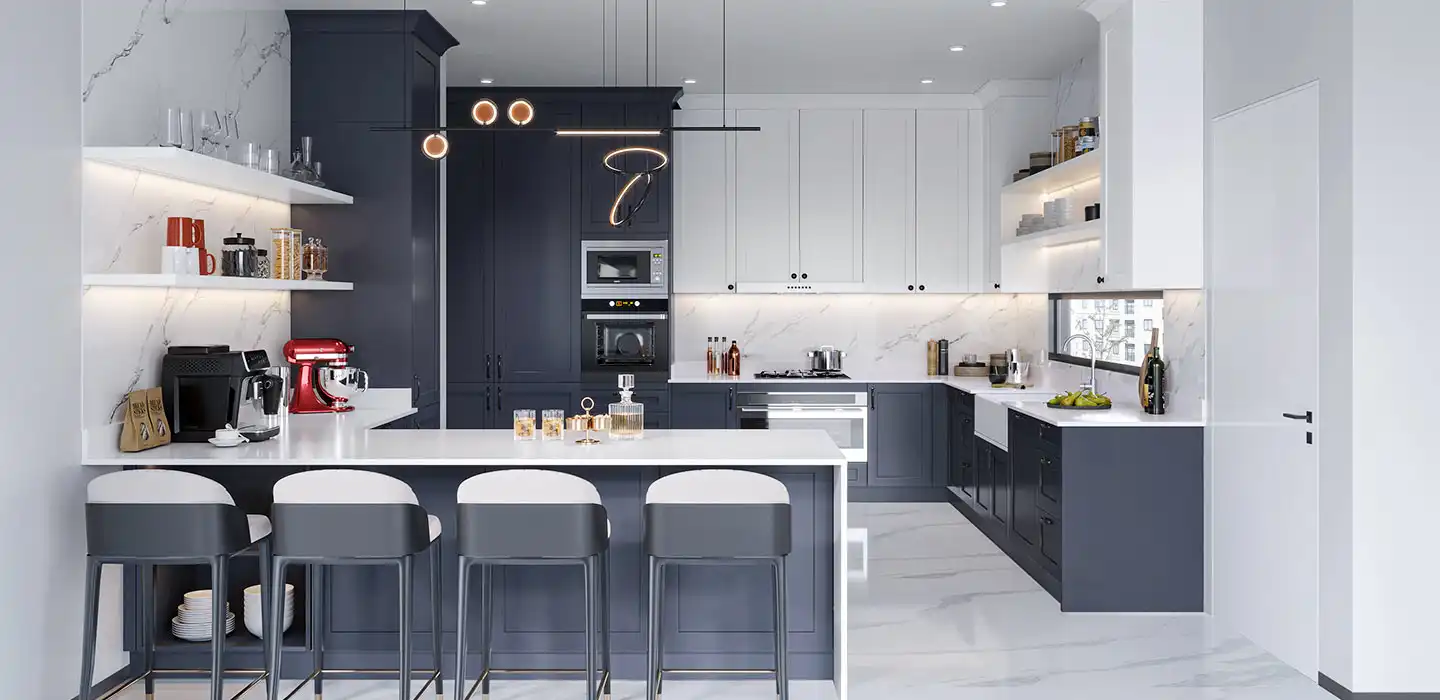When designing your space, there are two main types of kitchen cabinets to choose from: framed and frameless. But what is the difference between framed and frameless cabinets? Is one type better than the other?
Both have advantages and offer a wide range of functional and aesthetic options to do. Here are some variations between frameless and framed cabinets to assist you in deciding which one is best for your home project.
What Are Framed Cabinets?
Framed cabinets are sometimes known as “face frames” or “American frame cabinets” because they were invented in North America.
Framed cabinets include a supporting component that lays over the cabinet construction, whereas frameless cabinets do not.
The frame is intended to provide durability and strength, but it also means that the cabinet itself is made of thinner material. This is determined by the manufacturer. Frame cabinets, on the other hand, help minimize shelf misalignment issues that can cause cabinet boxes to tip or drawers or doors to shift.
Frame cabinets have a more traditional, American feel. Front frame makes door/drawer installation and conversion easy. Individual skin panels must be installed on exposed surfaces in the field. Framed cabinet series often offer additional dimensions and individual design options.
Advantages of Framed Cabinets
In this type of kitchen cabinet, the cabinet hinges are attached to the surface of the frame. This makes the cabinet hinges more sturdy and can add artistic detail when exposed.
The wood frame finish and 3/4 inch overlay give these cabinets a great vintage look. With the right design, color, and accessories, frame cabinets can provide a modern aesthetic, but for homes with more classic design tastes, frame cabinets are often a better option.
Shelves are typically adjustable, but the front frame may make access difficult once installed.
Very sturdy as the frame provides a flat and stable surface for mounting the cabinet door. The hinge is securely attached to the hardwood of the front frame.
Disadvantages of Frame Cabinets
Frame cabinets have limited storage space compared to frameless cabinets due to the front frame and center rail. If you already have limited space, frameless cabinets are a better option.
Frame cabinets take time to assemble and are difficult to modify once installed.
Note that the front jamb is visible even when the cabinet door is fully open.
What are frameless cabinets?
Frameless cabinets, as the name suggests, lack an additional frame in the cabinet structure. This gives you a little more storage space and easier access. Additionally, the case material can be thicker. They often look more modern.
Frameless cabinet, also known as “full access cabinets”, consists only of a cabinet box. There is no front frame connected to the cabinet structure, allowing full access to the cabinet interior. This design style originated in Europe and is often used to create a sleeker, cleaner look.
If you are planning a modern kitchen renovation, this may be the preferred option as the sleek look and flat drawer fronts complement the design.
Advantages of Frameless Cabinets
Eliminates the front frame, increasing internal space. Homeowners enjoy having large openings for storing dishes and kitchen utensils.
Flush exterior is standard on all frameless cabinetry and optional on framed cabinets. Because the edges of the drawers and doors are almost flush, frameless cabinet gives a modern and simple look.
Adjusting the shelves in frameless cabinets is easy because there is no front frame.
Door can be easily removed and cleaned without tools. Simply press the quick release button on the back of the door hinge.
Frameless cabinets do not have a center panel located in the middle of the two cabinet doors. Eliminating the center bar makes it easier to access the contents and increases storage space.
Frameless cabinetry panels can be left open for open shelf storage because there is no frame surrounding the cabinet opening.
No frame allows for even more design and aesthetic flexibility. Frameless cabinets are available in all styles including: B. traditional, transitional, modern, or contemporary.
Disadvantages of Frameless Cabinets
Frameless cabinets are often more difficult to install on uneven walls and can distort the cabinet above. The strength of frameless cabinetry depends solely on the frame of the cabinetry, so only high-quality materials should be used.
Frameless cabinets offer fewer sizing and customization options.
There are no standard overlay or inset structure options. Only full overlays are available.
Additional filler piece required to meet minimum clearance for door and drawer openings.
Hinges may be less robust because they are inserted directly into the side panels, which are often made of engineered wood, rather than into the front frame, which is usually made of hardwood.
Conclusion
All cabinet types are equal, so deciding which one is best for your kitchen will likely depend on your specific needs and good looks. If you want a more traditional look and don’t mind sacrificing some storage space, framed cabinets may be a better option. If you need as much storage space as possible and want a more modern look, a frameless cabinetry may be a better choice. Still not sure which products to use for your home kitchen project? The Oppein team provides expert design insights tailored to you.
